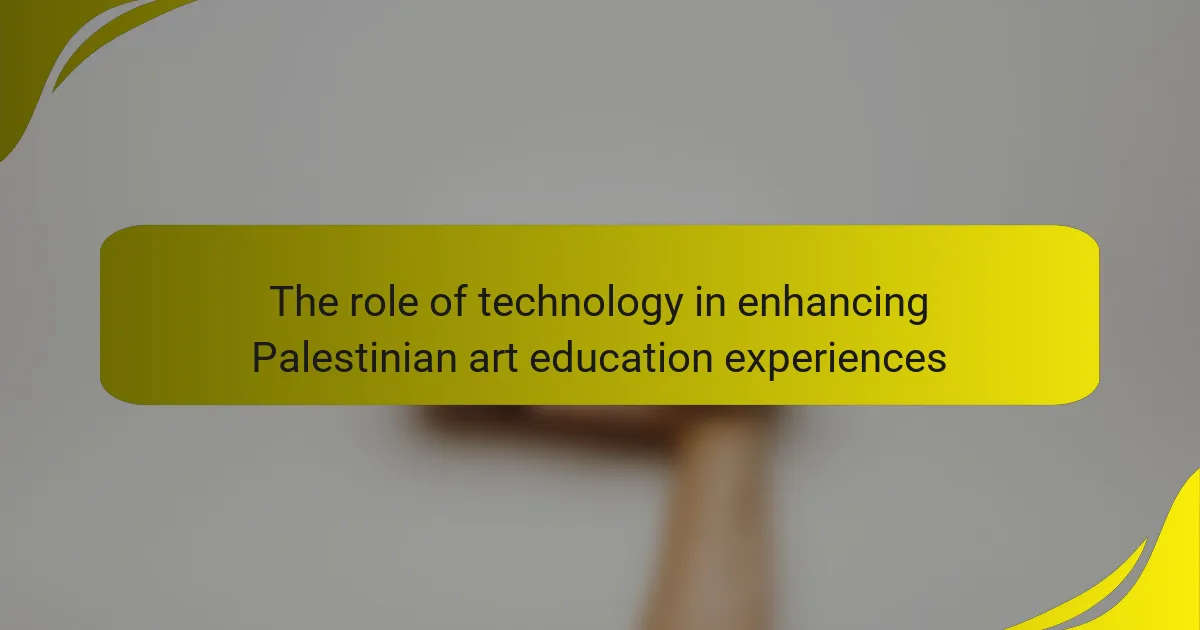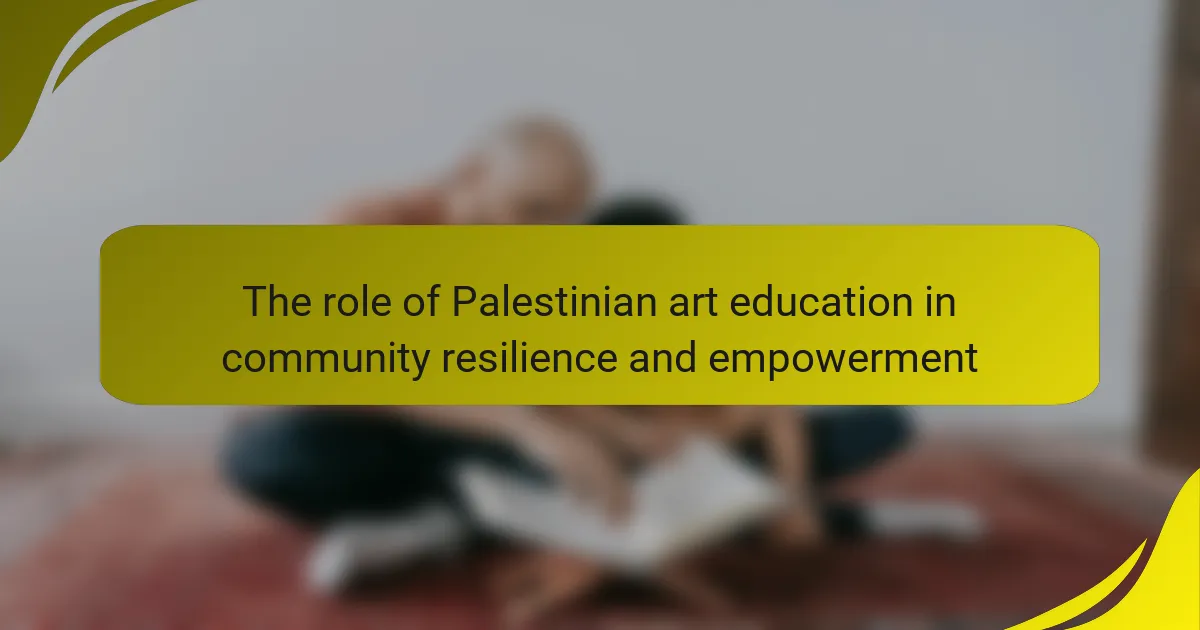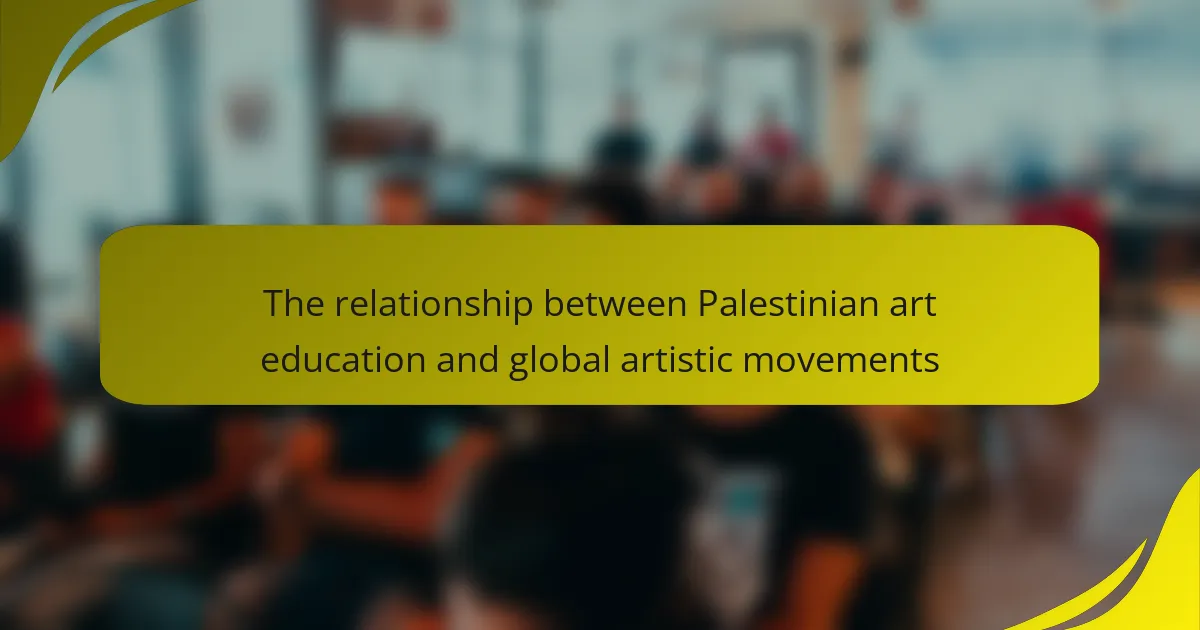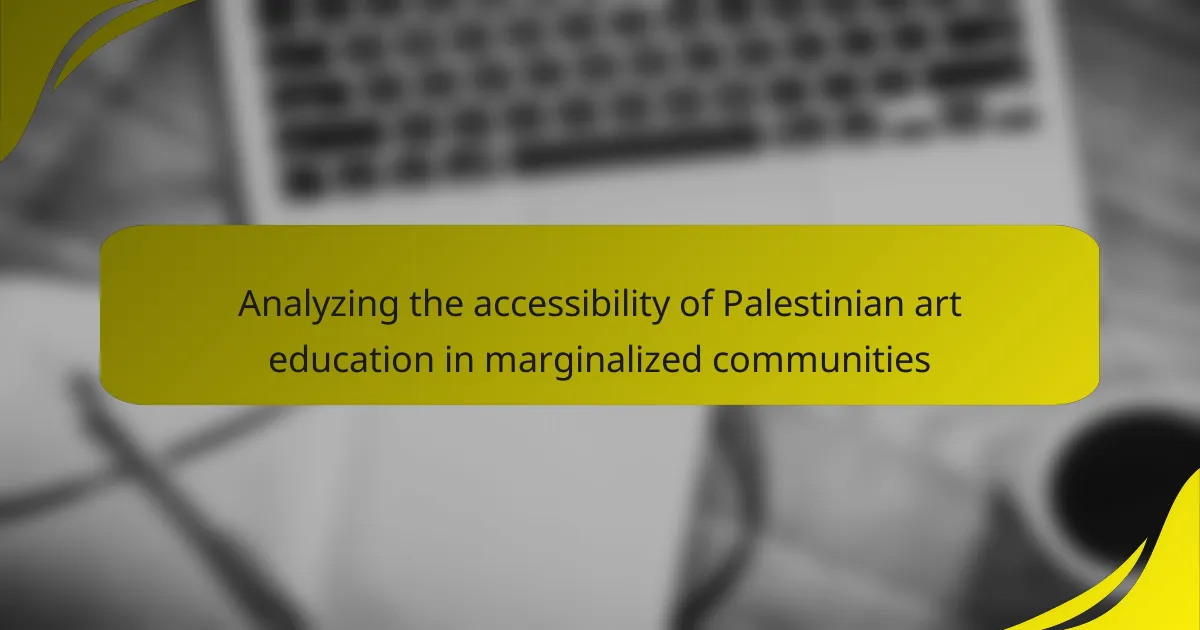Traditional art forms, including embroidery, pottery, and calligraphy, play a crucial role in the Palestinian art education curriculum by preserving cultural identity and enhancing students’ creativity. These art forms convey historical narratives and social values, fostering a sense of belonging among learners. Structured programs integrate hands-on activities and collaboration with local artisans, promoting cultural awareness and community involvement. Engagement with traditional arts not only boosts critical thinking skills but also supports personal development, emotional well-being, and academic performance. Overall, the inclusion of traditional art in education cultivates pride in Palestinian culture and nurtures artistic expression.
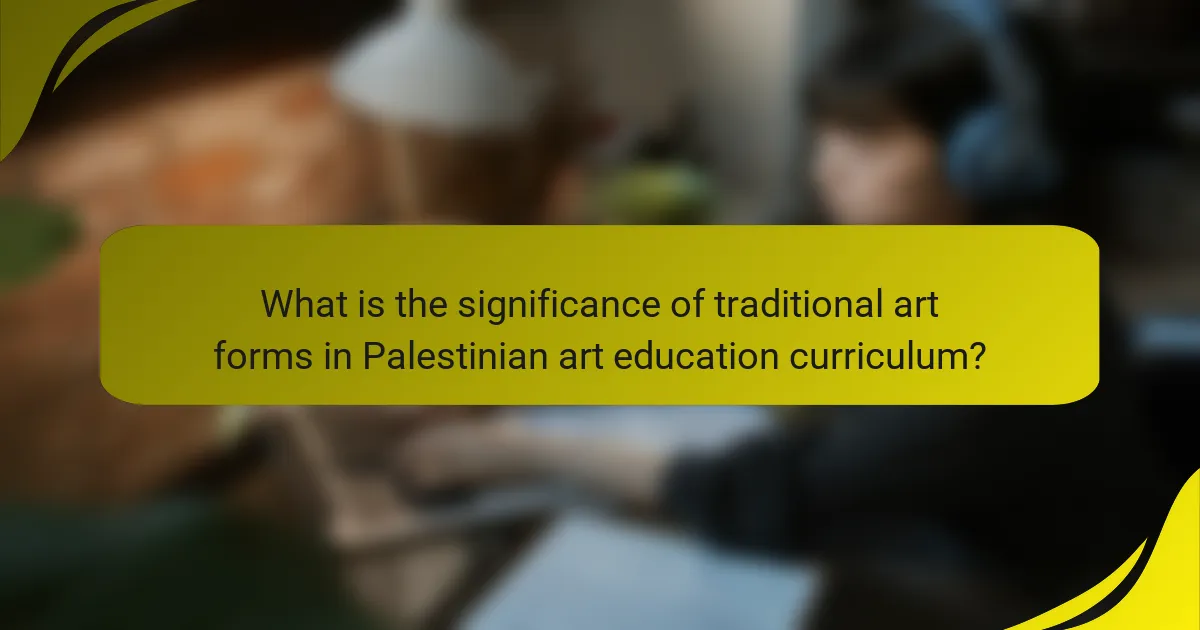
What is the significance of traditional art forms in Palestinian art education curriculum?
Traditional art forms are significant in the Palestinian art education curriculum as they preserve cultural identity. These art forms, such as embroidery and pottery, convey historical narratives and social values. Incorporating traditional art fosters a sense of belonging among students. It also enhances creativity by connecting learners to their heritage. Studies show that engagement with traditional arts improves students’ critical thinking skills. Furthermore, traditional art education promotes community involvement and intergenerational knowledge transfer. This curriculum approach cultivates pride in Palestinian culture and nurtures artistic expression. Overall, traditional art forms play a vital role in shaping the educational landscape in Palestine.
How do traditional art forms contribute to the cultural identity of Palestinian students?
Traditional art forms significantly contribute to the cultural identity of Palestinian students. They serve as a medium for expressing heritage and history. Students engage with art forms like embroidery, pottery, and music, which reflect Palestinian traditions. This engagement fosters a sense of belonging and pride in their cultural roots. Art education incorporates these traditional forms, enhancing students’ understanding of their identity. Research indicates that such practices can strengthen community ties and promote resilience among youth. For instance, the UNESCO report on cultural heritage highlights the role of traditional arts in identity formation. Thus, traditional art forms are vital in shaping the cultural identity of Palestinian students.
What are the key traditional art forms included in the curriculum?
The key traditional art forms included in the curriculum are Palestinian embroidery, pottery, and calligraphy. Palestinian embroidery, known as “tatreez,” features intricate patterns and vibrant colors. Pottery involves traditional techniques passed down through generations, often showcasing cultural motifs. Calligraphy emphasizes the artistic representation of Arabic script, highlighting its historical significance. These art forms are integral to preserving Palestinian cultural heritage and identity. They also foster creativity and self-expression among students.
How do these art forms reflect Palestinian heritage and history?
Traditional art forms in Palestine reflect the region’s heritage and history through their cultural symbolism and storytelling. These art forms, such as embroidery, pottery, and music, embody the values and traditions of Palestinian society. For instance, Palestinian embroidery often features patterns that represent local flora and fauna, showcasing a deep connection to the land. Additionally, traditional music incorporates historical narratives that preserve collective memories of resistance and identity. Historical events, such as the Nakba, are often depicted in visual arts, illustrating the impact of displacement on Palestinian culture. Overall, these art forms serve as a means of cultural expression and preservation, connecting generations to their roots and shared experiences.
Why is the integration of traditional art forms important in education?
The integration of traditional art forms is important in education because it fosters cultural identity and heritage preservation. Traditional art forms serve as a medium for students to connect with their cultural roots. This connection enhances students’ understanding of their history and traditions. Studies indicate that cultural education improves student engagement and motivation. For example, incorporating traditional crafts in the curriculum can lead to higher academic performance. Additionally, traditional art forms encourage creativity and critical thinking skills. They provide a unique way for students to express themselves artistically. Ultimately, integrating these forms enriches the educational experience and promotes cultural awareness.
How does traditional art enhance creativity and critical thinking among students?
Traditional art enhances creativity and critical thinking among students by fostering innovative expression and problem-solving skills. Engaging in traditional art forms allows students to explore diverse cultural narratives. This exploration encourages them to think outside the box and generate unique ideas. Additionally, traditional art techniques require students to make decisions about composition, color, and materials. Such decision-making processes cultivate critical thinking abilities. Research indicates that art education can improve cognitive skills, including analysis and synthesis. For instance, a study by Catterall (2002) found that students involved in arts education performed better on standardized tests. This evidence supports the claim that traditional art significantly contributes to enhancing creativity and critical thinking in students.
What role does traditional art play in promoting community engagement?
Traditional art plays a crucial role in promoting community engagement. It fosters cultural identity and pride among community members. Traditional art forms often involve collaborative practices, bringing individuals together to create. These activities strengthen social bonds and encourage dialogue. Community festivals featuring traditional art enhance participation and interaction among diverse groups. Research shows that engagement in traditional art activities can lead to increased community cohesion. For instance, studies indicate that art workshops in Palestinian communities have successfully united participants across various backgrounds. This highlights the power of traditional art in building a sense of belonging and collective purpose.
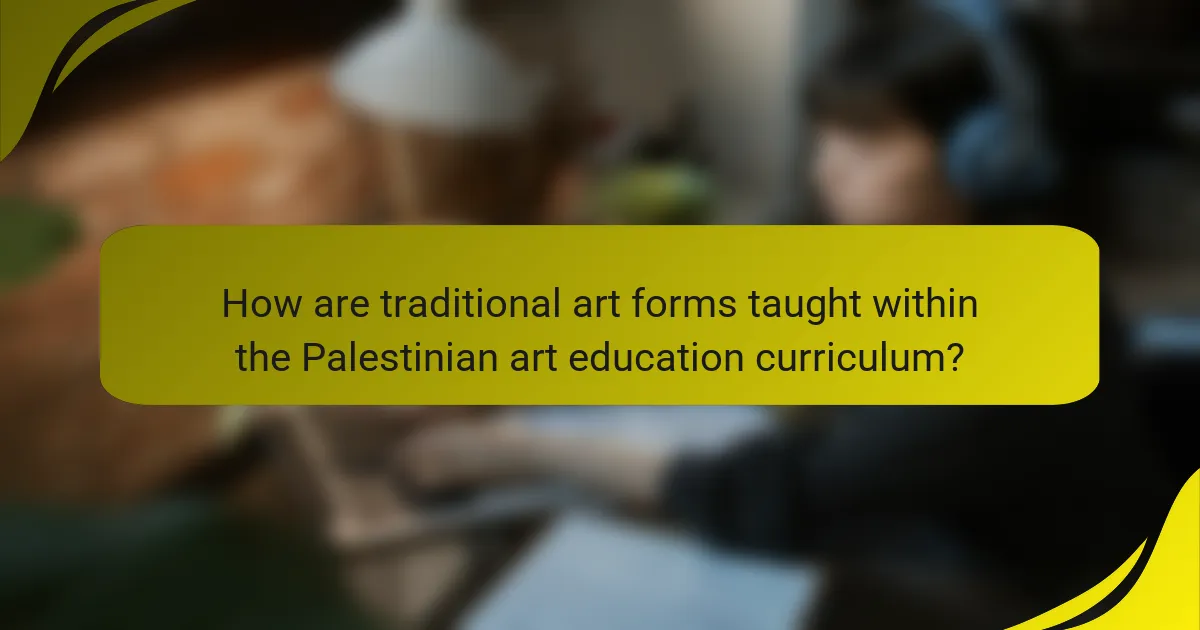
How are traditional art forms taught within the Palestinian art education curriculum?
Traditional art forms are integrated into the Palestinian art education curriculum through structured programs. These programs emphasize cultural heritage and artistic techniques. Students learn about various traditional mediums, including embroidery, pottery, and calligraphy. Instruction often includes historical context to enhance understanding. Workshops and hands-on activities are common, allowing students to practice traditional methods. Collaboration with local artisans enriches the learning experience. Educational institutions often incorporate community projects to promote cultural awareness. This approach fosters a sense of identity and pride among students.
What teaching methods are used to incorporate traditional art forms?
Teaching methods used to incorporate traditional art forms include experiential learning, project-based learning, and collaborative learning. Experiential learning allows students to engage directly with traditional techniques and materials. This method promotes hands-on experience, enhancing understanding and appreciation. Project-based learning encourages students to create artworks that reflect traditional styles and themes. This approach fosters creativity while grounding students in cultural context. Collaborative learning involves group activities where students share knowledge and techniques. This method builds community and reinforces cultural heritage. These methods have been shown to increase student engagement and cultural awareness in art education.
How do educators assess students’ understanding of traditional art?
Educators assess students’ understanding of traditional art through various methods. They utilize formative assessments such as class discussions and critiques. These methods encourage students to articulate their thoughts on traditional art. Additionally, educators may employ practical assignments that require students to create traditional art pieces. This hands-on approach allows students to demonstrate their skills and knowledge. Rubrics are often used to evaluate these assignments objectively. They provide clear criteria for grading, focusing on creativity, technique, and adherence to traditional styles. Educators also conduct summative assessments, such as quizzes and exams, to gauge students’ theoretical knowledge. These assessments often include questions about historical context and cultural significance. Collectively, these methods provide a comprehensive view of students’ understanding of traditional art.
What resources are available for teaching traditional art forms?
Resources available for teaching traditional art forms include textbooks, online courses, and workshops. Textbooks provide foundational knowledge and techniques specific to traditional art. Online courses offer flexible learning options and often include video tutorials. Workshops allow hands-on experience with expert guidance. Community centers and cultural institutions frequently host events focused on traditional art. Additionally, local artists often share their expertise through mentorship programs. These resources support the integration of traditional art forms into educational curricula.
What challenges do educators face in teaching traditional art forms?
Educators face several challenges in teaching traditional art forms. Limited resources hinder access to materials and training. Many educators lack adequate knowledge of these art forms. Cultural preservation is often overshadowed by modern art trends. There is a scarcity of qualified instructors who specialize in traditional techniques. Additionally, students may show less interest in traditional methods compared to contemporary styles. The integration of traditional art into the curriculum can be difficult due to rigid educational structures. These challenges affect the effectiveness of teaching and learning traditional art forms.
How do socio-political factors impact the teaching of traditional art?
Socio-political factors significantly impact the teaching of traditional art. These factors shape the curriculum, resources, and accessibility of art education. Political instability can limit funding for art programs. In regions like Palestine, restrictions on movement affect artists’ ability to share their culture. Historical narratives are often influenced by political agendas. This can lead to the marginalization of certain art forms. Additionally, socio-political contexts can foster a sense of identity through traditional art. Educators may emphasize traditional art as a form of resistance. This highlights the importance of cultural heritage in art education. Overall, socio-political dynamics play a crucial role in shaping the teaching of traditional art.
What strategies can be employed to overcome these challenges?
Integrating traditional art forms into the Palestinian art education curriculum can be enhanced through several strategies. First, collaboration with local artists can provide authentic insights and techniques. Workshops led by these artists can engage students and foster hands-on learning. Second, incorporating cultural history into lessons can deepen students’ understanding of the significance of traditional art. This approach connects art to identity and heritage. Third, utilizing community resources, such as local galleries and museums, can create exposure to traditional artworks. Field trips can enhance appreciation and contextualize learning. Additionally, developing partnerships with educational institutions can facilitate resource sharing and curriculum development. These strategies collectively address challenges by enriching the educational experience and preserving cultural heritage.
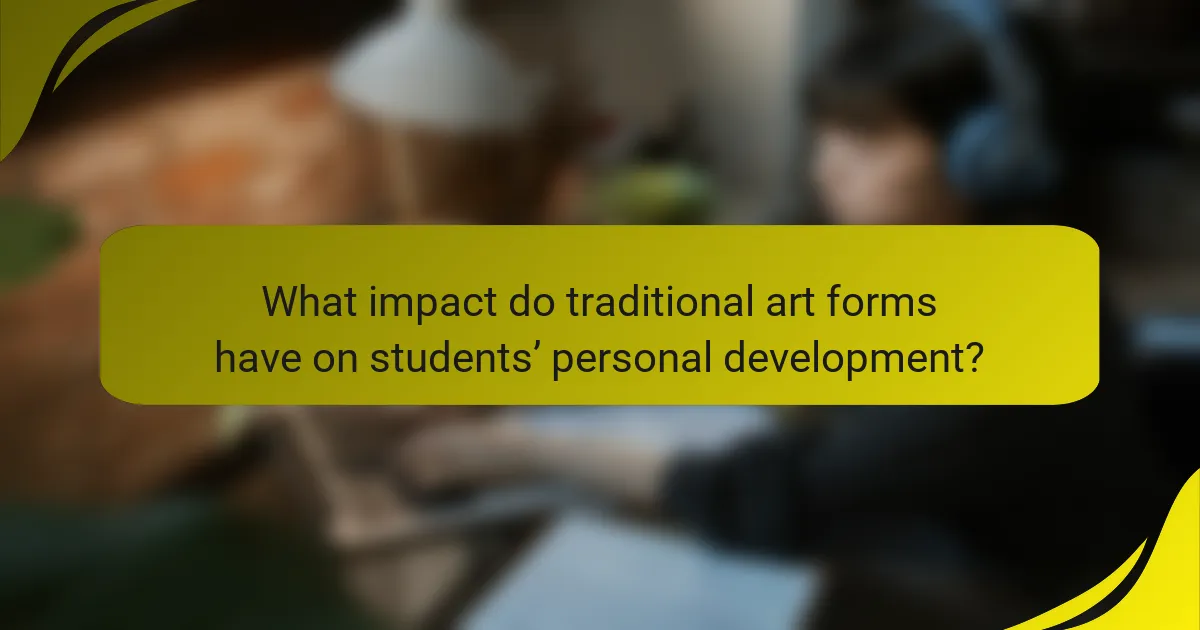
What impact do traditional art forms have on students’ personal development?
Traditional art forms significantly enhance students’ personal development. They foster creativity and self-expression. Engaging in traditional art promotes critical thinking skills. Students learn to appreciate cultural heritage through these art forms. This appreciation builds a sense of identity and belonging. Furthermore, participation in art activities boosts confidence and self-esteem. Research indicates that students involved in the arts exhibit improved emotional well-being. Studies show that art education can lead to better academic performance and social skills.
How do traditional art forms influence students’ self-expression?
Traditional art forms significantly influence students’ self-expression by providing cultural context and emotional outlets. These forms encourage creativity and individual interpretation. Students engage with their heritage through traditional techniques and motifs. This engagement fosters a sense of identity and belonging. Research indicates that art education enhances self-esteem and personal voice. A study by the National Art Education Association found that students involved in traditional art experience greater emotional expression. Furthermore, traditional art forms often incorporate storytelling, enriching the personal narratives of students. This connection to cultural roots empowers students to express unique perspectives.
What skills do students develop through engaging with traditional art?
Students develop various skills through engaging with traditional art. These skills include creativity, critical thinking, and cultural awareness. Creativity is fostered as students explore different artistic techniques and express their thoughts visually. Critical thinking is enhanced when students analyze traditional art forms and their meanings. Cultural awareness is developed as students learn about the history and significance of traditional art in their community. Additionally, students improve their fine motor skills through hands-on activities. They also gain collaboration skills by working on group projects. Overall, engaging with traditional art equips students with essential life skills.
How does participation in traditional art foster a sense of belonging?
Participation in traditional art fosters a sense of belonging by connecting individuals to their cultural heritage. Engaging in traditional art forms allows participants to express their identity and share their history. This shared experience creates a communal bond among individuals. Traditional art often involves collaborative practices, enhancing social interaction. Such participation reinforces cultural narratives and collective memory. Research indicates that involvement in cultural activities boosts social cohesion. In Palestinian contexts, traditional art serves as a means of resistance and identity affirmation. This engagement cultivates pride and belonging within the community.
What are the long-term benefits of incorporating traditional art forms in education?
Incorporating traditional art forms in education fosters cultural identity and enhances creativity. Students develop a deeper understanding of their heritage through traditional art. This connection can lead to increased self-esteem and pride in cultural background. Engaging with traditional art encourages critical thinking and problem-solving skills. Research indicates that students exposed to the arts perform better academically. A study by the Arts Education Partnership found that arts education improves student engagement and achievement. Additionally, traditional art forms promote social cohesion and community involvement. These long-term benefits contribute to a more well-rounded education.
How do traditional art forms contribute to the preservation of cultural heritage?
Traditional art forms play a crucial role in preserving cultural heritage. They serve as a medium for transmitting values, beliefs, and historical narratives. Through techniques passed down generations, these art forms maintain cultural identity. For instance, traditional crafts like pottery and weaving reflect local customs and practices. Participation in these art forms fosters community engagement and collective memory. Studies show that engaging with traditional art enhances cultural awareness among younger generations. This connection to heritage helps combat cultural erosion. Thus, traditional art forms are vital for sustaining cultural heritage over time.
What future opportunities arise from a strong foundation in traditional art?
A strong foundation in traditional art opens various future opportunities in creative fields. It enhances cultural preservation and identity, fostering community engagement. Traditional art skills can lead to careers in teaching, where educators pass on techniques to future generations. Additionally, artists can innovate by blending traditional methods with modern practices, attracting diverse audiences. The growing interest in cultural tourism can create opportunities for artisans to showcase their work. Furthermore, traditional art can inspire collaborations with contemporary artists, leading to unique projects. These avenues contribute to the economic development of communities by promoting local craftsmanship and heritage.
What best practices can educators implement when teaching traditional art forms?
Educators can implement several best practices when teaching traditional art forms. First, they should integrate local cultural context into the curriculum. This helps students connect personally with the art forms. Second, hands-on experience is essential. Students benefit from actively engaging in the creation of traditional artworks. Third, collaboration with local artisans can enhance learning. This provides students with authentic insights into techniques and practices. Fourth, utilizing storytelling can enrich the educational experience. Narratives about the history and significance of the art forms contextualize their relevance. Fifth, encouraging critical thinking is vital. Students should analyze and reflect on the impact of traditional art in their culture. Finally, incorporating technology can modernize the teaching approach. Digital tools can help document and share students’ artworks. These practices collectively foster a deeper understanding and appreciation of traditional art forms in the Palestinian context.
The main entity of this article is traditional art forms within the Palestinian art education curriculum. The article highlights the significance of these art forms, such as embroidery, pottery, and calligraphy, in preserving cultural identity and enhancing students’ understanding of their heritage. It discusses how traditional art fosters creativity, critical thinking, and community engagement among students, while also outlining the teaching methods, assessment strategies, and resources available for educators. Additionally, the article addresses the challenges faced in teaching traditional art and the long-term benefits of incorporating these forms into education, emphasizing their role in cultural heritage preservation and personal development for students.
